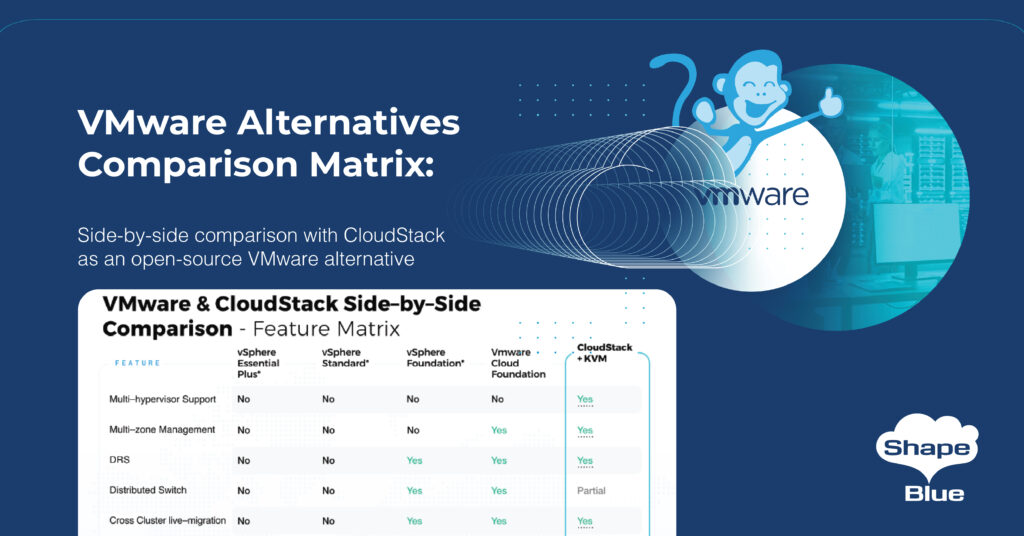Are you one of the 45% of virtualization users currently relying on VMware, suddenly grappling with the repercussions of Broadcom's recent licensing model overhaul? The shift has ignited a widespread reassessment of virtualized infrastructures, prompting a critical examination of VMware alternatives, a move that could redefine your organization's future in the cloud.
The landscape of virtualization is experiencing a significant upheaval. VMware, a long-standing industry leader, is facing a period of transformation following its acquisition by Broadcom. This has sparked a wave of uncertainty among its user base, prompting organizations of all sizes to re-evaluate their virtualization strategies. For many, this means exploring alternatives. But with a multitude of options available, the decision-making process can feel daunting.
Here's a comprehensive look at some prominent VMware alternatives, their unique strengths, and the scenarios where they shine. We'll delve into the nuances of cost, scalability, support, hardware compatibility, and the overall user experience to equip you with the knowledge needed to make an informed choice. This article is designed to provide a clear, concise, and objective overview of the virtualization landscape, offering practical guidance for businesses navigating this crucial transition.
- Bollyflix Watch Bollywood South Indian Movies Online 2024
- Explore Vega More Free Streaming Thriller Insights
Navigating the complexities of virtualization can be overwhelming, but understanding the core principles is essential. At its heart, virtualization involves creating virtual versions of physical resources computers, networks, and storage devices. This technology allows a single physical server to host multiple virtual machines (VMs), each operating independently with its own operating system and applications. This approach enhances resource utilization, reduces hardware costs, and simplifies IT management. However, the methods for creating and managing these virtual systems vary significantly across different solutions, impacting their functionality, ease of use, and the features they offer.
One of the primary drivers behind the shift away from VMware is the change in its licensing model. Following Broadcom's acquisition, VMware has altered its pricing structure, often resulting in higher costs for existing customers. This has led many organizations to seek more cost-effective alternatives, particularly those with large deployments or specific budget constraints. The financial implications are a crucial factor in the decision-making process, making a thorough cost-benefit analysis essential.
Choosing the right VMware alternative is not a one-size-fits-all scenario. The ideal solution depends on a combination of factors, including your organization's size, specific needs, long-term goals, and available budget. A small business might prioritize ease of use and affordability, while a large enterprise may value advanced features, robust support, and seamless integration with existing infrastructure. The following sections will explore several popular alternatives, examining their features, advantages, and disadvantages to help you determine which option aligns best with your unique requirements.
It is important to remember that scalability is a key factor to consider in any VMware alternative. As your business grows, your virtualization solution must be able to accommodate an increasing number of virtual machines without compromising performance or stability. The chosen alternative should provide the ability to deploy multiple virtual machines as needed, quickly and easily. This often involves considerations of resource allocation, load balancing, and the ability to scale resources up or down based on demand.
Furthermore, the selected alternative should consistently deliver a high level of performance, security, and stability. The virtualized environment must operate smoothly, with minimal downtime and a robust defense against potential security threats. It's essential to perform due diligence, including testing the solution in your environment and evaluating its performance under various load conditions.
Before diving into specific alternatives, it's beneficial to understand the key factors to evaluate. Consider these aspects to determine the best fit for your business:
- Cost: Analyze licensing fees, support costs, and potential hidden charges. Consider both initial and ongoing costs.
- Scalability: Verify the ability to handle increasing workloads and the ease of adding more virtual machines.
- Support: Examine the availability of technical support, documentation, and community resources.
- Hardware Compatibility: Ensure compatibility with your existing hardware infrastructure.
- Features: Identify the features that are crucial for your business, such as high availability, disaster recovery, and advanced management tools.
- Ease of Use: Evaluate the user-friendliness of the interface, including the simplicity of setup, management, and maintenance.
- Integration: Ensure seamless integration with your existing IT environment, including operating systems, applications, and cloud services.
- Performance: Evaluate the performance impact on your workload, considering factors such as CPU, memory, and storage utilization.
- Security: Assess security features such as access control, encryption, and vulnerability patching.
Now, let's explore some of the most promising VMware alternatives available in the market. The following list presents several platforms, each with its own unique capabilities. Each option will be examined according to the above factors.
| Alternative | Key Features | Advantages | Disadvantages | Use Cases |
|---|---|---|---|---|
| Proxmox VE | KVM-based virtualization, Web-based management interface, Software-defined storage integration, Live migration capabilities | Open-source, robust, cost-effective, feature-rich | Can have a steeper learning curve for some users. | Organizations prioritizing control, cost-effectiveness, and the benefits of open-source technology. |
| Microsoft Hyper-V | Native integration with Windows Server, Live migration, Free of charge with Windows Server. | Free for Windows server users, seamless integration with Windows workloads, mature technology. | Limited feature set compared to other solutions. Tied to Windows Server, which may not be suitable for all environments. | Businesses heavily invested in the Microsoft ecosystem. |
| Citrix Hypervisor (formerly XenServer) | Mature and established solution, High performance, Supports a wide variety of guest OS's. | Good performance and security, well-suited for VDI. | Can be more complex to set up and manage. Requires Citrix license for commercial use. | Businesses or organizations that need VDI implementation and desktop virtualization. |
| Red Hat Virtualization (RHV) | Built upon KVM, offers advanced features, and supports integration with Red Hat's management tools. | Open-source, strong integration with Red Hat's ecosystem, good for Red Hat users. | Potentially less mature than VMware. | Red Hat customers seeking a VMware alternative. |
| Nutanix AHV | Integrated virtualization platform as part of the Nutanix HCI (hyperconverged infrastructure) solution. | Offers simplified management, strong integration, and enterprise-grade features. | Tied to Nutanix hardware. Can be more expensive than standalone solutions. | Organizations looking for hyperconverged infrastructure. |
| Scale Computing HC3 | Hyperconverged infrastructure. | Simplified management. Good support. | Hardware-based. | Small to medium-sized businesses and distributed enterprises |
| Verge.IO | Virtualization solution focused on simplicity and ease of use. | Easy to deploy, use and manage. | Newer to the market. | Organizations wanting a simple and easy-to-manage platform |
| Oracle VM VirtualBox | Open-source, cross-platform virtualization software. | Free, easy to use. Can be installed on many different operating systems | Not enterprise-grade, suitable for personal use. | Individuals and small teams |
| Azure VMware Solution (AVS) | Provides VMware infrastructure on Microsoft Azure. | Seamless integration with Azure services. | Requires running VMware in the cloud. | Organizations planning a move to Azure cloud. |
Proxmox VE, is an open-source virtualization platform based on KVM (Kernel-based Virtual Machine) and LXC (Linux Containers). It allows users to create and manage virtual machines and containers through a web-based interface. Its features include software-defined storage integration, live migration, and a robust set of tools for virtual machine management. For organizations prioritizing control and cost-effectiveness, Proxmox VE is an excellent choice. Its a robust and feature-rich option, but may have a steeper learning curve compared to some other solutions.
Microsoft Hyper-V, natively integrated within Windows Server, provides a straightforward virtualization solution at no additional cost. Hyper-V offers seamless integration and support for Windows workloads, making it an excellent option for businesses heavily invested in the Microsoft ecosystem. However, its features may be limited compared to other solutions, especially in non-Microsoft environments. Hyper-V offers features such as live migration, which allows VMs to be moved between physical hosts without downtime. Hyper-V is a solid choice for enterprises focusing on windows server workloads.
Citrix Hypervisor (formerly XenServer) is a mature and well-established solution known for its performance and suitability for virtual desktop infrastructure (VDI). It offers strong security features and supports a wide variety of guest operating systems. It is well-suited for companies that need VDI implementation and desktop virtualization, but can be more complex to set up and manage. Citrix licenses are also required for commercial use.
Red Hat Virtualization (RHV) is built upon KVM and offers advanced features, including integration with Red Hat's management tools. This is a solid option for Red Hat customers and those considering a switch from VMware. RHV is open-source, offering strong integration with Red Hat's ecosystem. For Red Hat customers or those considering a switch from VMware, the platform provides tools for migrating customers virtual machines. RHV can be a strong choice for those organizations who have invested in Red Hat infrastructure.
Nutanix AHV is an integrated virtualization platform designed to be part of the Nutanix HCI (hyperconverged infrastructure) solution. Nutanix AHV is designed to simplify management and offer enterprise-grade features. It offers simplified management and strong integration. It's also good if an organization is looking for hyperconverged infrastructure.
Scale Computing HC3 simplifies virtualization through its hyperconverged infrastructure, offering streamlined management and a good level of support. Its primary disadvantage is that it relies on hardware from the vendor. Small to medium-sized businesses and distributed enterprises may find Scale Computing HC3 a compelling solution.
Verge.IO offers a virtualization solution centered on simplicity and ease of use. It prioritizes simplicity and ease of use, making it accessible. It's easy to deploy, use, and manage. Verge.IO is a good option for organizations wanting a simple and easy-to-manage platform.
Oracle VM VirtualBox is an open-source, cross-platform virtualization software. Its primary benefit is that it is free and easy to use, but is not designed for enterprise environments. Individuals and small teams can leverage this for their projects.
Azure VMware Solution (AVS) provides a way to run VMware infrastructure on Microsoft Azure. It provides seamless integration with Azure services, but comes with the requirement of running VMware in the cloud. Organizations planning a migration to Azure should evaluate AVS.
In addition to the direct VMware alternatives listed above, some organizations might consider the potential of containerization. With the rise of containerization technologies like Docker and Kubernetes, the opportunity to modernize apps may be an appealing alternative for some customers. Modernizing applications through containerization can lead to increased agility, scalability, and portability, allowing organizations to move away from traditional virtual machine-based infrastructure.
Before making your decision, remember the importance of a thorough evaluation of your current infrastructure, team capabilities, and future goals. Carefully consider the cost, scalability, support, and hardware compatibility of each alternative. By understanding your specific requirements and taking the time to analyze the options, you can make the best choice and secure the continued success of your virtualized infrastructure.
Ultimately, selecting the right VMware alternative is a strategic decision. The future of your organization depends on the best solution. By considering all factors, your organization can make the decision that will take you to new heights.


